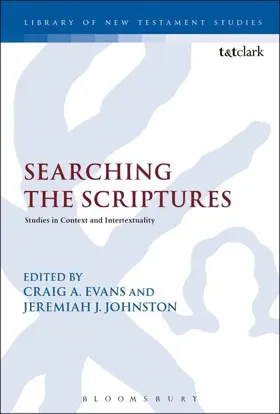

Searching the Scriptures: Studies in Context and Intertextuality
in Library of New Testament Studies
Pages
336
Publisher
T&T Clark
Published
9/24/2015
ISBN-13
9780567663825
This work critically engages the hermeneutical methods used to analyse the New Testament writings, so that the lenses through which studies of the texts have been traditionally viewed can be revised. Jeremy Hultin contributes an article on the rhetorical use of the chosen citations by Jewish rabbis in their commentary on scripture, while Mark Gignilliat writes on the potential implications for viewing Old Testament Scripture in the manner of the early Church exegetes and theologians. With these two contributions providing a frame for the other chapters, the essays explore a range of topics including the significance of the number 42 in Matthew; the study of Wisdom in Matthew, the extent to which the four gospels are underlined by Hebrew material, if any; the use of Hebrew material in shaping New Testament writings; and the uses of Scripture in the letters of Paul and the letters to the Hebrews.
Read separately, these articles provide fascinating insights and revisions to established ideas on intertextuality between the Old/Hebrew Bible and the New Testament writings. Taken together, the collection presents a solid argument for the fundamental revision of our current hermeneutical practice in Biblical Studies.
Read separately, these articles provide fascinating insights and revisions to established ideas on intertextuality between the Old/Hebrew Bible and the New Testament writings. Taken together, the collection presents a solid argument for the fundamental revision of our current hermeneutical practice in Biblical Studies.
- Table Of Contents
- Preface
- Abbreviations
- List of Contributors
- Introduction
- General Studies
- 1: Singing Women and Promised Seed Isaiah 54: 1-3 as Christian Scripture Mark S. Gignilliat, Beeson Divinity School, USA
- 2: Genesis Rabbah 48:1-6: Reflections on Thematic Unity and Exegetical Method Jeremy F. Hultin, Murdoch University, Australia
- Studies in the Gospels
- 3: Metaphorty-Two? The Wilderness and the People of God in Matthew 1: 1-17 Jason B. Hood, Christ United Methodist Church, USA
- 4: “The Rejection of Wisdom's Call": Matthew's use of Proverbs 1:20-33 in the Parable of Children in the Marketplace (Matthew 11:16-19/Luke 7: 31-35) Brian C. Dennert, Loyola University, USA
- 5: John, Elijah and Naboth: What Does 1 Kings 21 Have to do with Matthew 14? Jesse Rainbow, Harvard University, USA
- 6: Jesus as a Nazarite in Mark 14:25 Par., and Joseph's Reunion Meal in Judaic Tradition Roger D. Aus, Lutherkirchengemeinde Alt-Reinickendorf, Germany
- 7: The Hebrew Scriptures in the Third Gospel R. Steven Notley, Nyack College, USA and Jeffrey Garcia, New York University, USA
- 8: Intertextual Wisdom: Luke 12:13-34 and the Sapiental Conversation on Death and Possessions Matthew S. Rindge, Gonzaga University, USA
- 9: Jesus said "Keep the Commandments" and the Rich Man asked "Which Ones?" The Decalogue as a Law Summary in the Story of the Rich Man Diane Hakala, University of Cambridge, UK
- 10: They Shall Look Upon the One they have Pierced: Intertextuality, Intra-textuality, and Anti-Judaism in John 19:37 Ruth Sheridan, Charles Sturt University, Australia
- Studies in the Letters
- 11: Toward a Theory of Narrative Transformation: The Importance of Both Contexts in Paul's Scriptural Citations J. R. Daniel Kirk, Fuller Theological University, USA
- 12: Dominical Shame Tradition in Paul: An Allusion (Rom 1:16) to Jesus' Use of Shame Language (Mark 8: 38) from the Book of Daniel Yongbom Lee, Los Angeles Antioch Presbyterian Church, USA
- 13: 'We Know that Whatever Law SAys…': Romans 3:9–20 as a Narrative Utilization of Intertextuality Developing its own Theory of Intertextuality Alain Gignac, Universite de Montreal, Canada
- 14: Crushing Satan: Genesis 2-3 in Romans 16: 17-20A Brian LePort, University of Bristol, UK
- 15: The Convergence of Adamic and Merkabah Traditions in the Christology of Hebrews Silviu N. Bunta, University of Dayton, USA
- Bibliography
- Index
Inner Books
This physical volume has several internal sections, each of which has been reviewed independently
- Singing Women and Promised Seed Isaiah 54: 1-3 as Christian Scripture by Mark S. Gignilliat
- Genesis Rabbah 48:1-6: Reflections on Thematic Unity and Exegetical Method by Jeremy F. Hultin
- Metaphorty-Two? The Wilderness and the People of God in Matthew 1: 1-17 by Jason B. Hood
- "The Rejection of Wisdom's Call": Matthew's use of Proverbs 1:20-33 in the Parable of Children in the Marketplace (Matthew 11:16-19/Luke 7: 31-35) by Brian C. Dennert
- John, Elijah and Naboth: What Does 1 Kings 21 Have to do with Matthew 14? by Jesse Rainbow
- Jesus as a Nazarite in Mark 14:25 Par., and Joseph's Reunion Meal in Judaic Tradition by Roger D. Aus
- The Hebrew Scriptures in the Third Gospel by R. Steven Notley and Jeffrey Garcia
- Intertextual Wisdom: Luke 12:13-34 and the Sapiental Conversation on Death and Possessions by Matthew S. Rindge
- Jesus said "Keep the Commandments" and the Rich Man asked "Which Ones?" The Decalogue as a Law Summary in the Story of the Rich Man by Diane Hakala
- They Shall Look Upon the One they have Pierced: Intertextuality, Intra-textuality, and Anti-Judaism in John 19:37 by Ruth Sheridan
- Toward a Theory of Narrative Transformation: The Importance of Both Contexts in Paul's Scriptural Citations by J. R. Daniel Kirk
- Dominical Shame Tradition in Paul: An Allusion (Rom 1:16) to Jesus' Use of Shame Language (Mark 8: 38) from the Book of Daniel by Yongbom Lee
- 'We Know that Whatever Law SAys…': Romans 3:9–20 as a Narrative Utilization of Intertextuality Developing its own Theory of Intertextuality by Alain Gignac
- Crushing Satan: Genesis 2-3 in Romans 16: 17-20A by Brian LePort
- The Convergence of Adamic and Merkabah Traditions in the Christology of Hebrews by Silviu N. Bunta